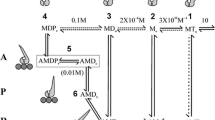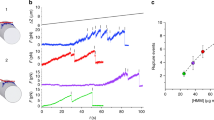Summary
The isolated contractile proteins of the slime mouldPhysarum polycephalum and of rabbit skeletal muscle were investigated by using actomyosin thread models. The actomyosins were compared with respect to contraction behaviour, fine structure, and ATPase activity. Thread models were made of natural and synthetic actomyosins of both systems.
The natural actomyosins differ considerably: The actin filament length ofPhysarum actomyosin is only about one fourth, the ATPase activity and actin/myosin ratio are much lower compared to natural muscle actomyosin. The contraction rate of the natural slime mould actomyosin is remarkably slower than that of the natural muscle actomyosin.
The synthetic actomyosins were formed from separately isolated actins and myosins with a constant actin/myosin ratio and comparable actin filament lengths. The thread models of either recombined and hybridized actomyosins of both systems contract with nearly identical rates. The comparison of the synthetic actomyosins shows that under comparable conditions a) the actomyosins of both systems perform work with the same efficiency, b) the actin and myosin component is freely exchangeable without any change in the rate of actomyosin contraction. These results indicate that in both skeletal muscle and slime mould the force generation is based on the same mechanism of actin-myosin interaction.
Similar content being viewed by others
Literatur
Adelmann, M. R., undE. W. Taylor, 1969: Further purification and characterization of slime mold myosin and slime mold actin. Biochemistry8, 4976–4988.
Bárány, M., 1967: ATPase activity of myosin correlated with speed of muscle shortening. J. gen. Physiol.50, Teil 2, 197–218.
Beck, R., H. Komnick, W. Stockem undK. E. Wohlfarth-Bottermann, 1969: Weitreichende fibrilläre Protoplasmadifferenzierungen und ihre Bedeutung für die Protoplasmaströmung. IV. Vergleichende Untersuchungen an Actomyosin-Fäden und glycerinierten Zellen. Cytobiologie1, 99–144.
—,H. Hinssen, H. Komnick, W. Stockem undK. E. Wohlfarth-Bottermann, 1970 a: Weitreichende fibrilläre Protoplasmadifferenzierungen und ihre Bedeutung für die Protoplasmaströmung. V. Kontraktion, ATPase-Aktivität und Feinstruktur isolierter Actomyosin-Fäden vonPhysarum polycephalum. Cytobiologie2, 259–274.
—,H. Komnick, W. Stockem undK. E. Wohlfarth-Bottermann, 1970 b: Weitreichende fibrilläre Protoplasmadifferenzierungen und ihre Bedeutung für die Protoplasmaströmung. VI. Vergleichende Untersuchungen an isolierten Actomyosin-Fäden schräggestreifter und glatter Muskulatur. Cytobiologie2, 413–428.
Boehm, G., undH. H. Weber, 1932: Das Röntgendiagramm von gedehnten Myosinfäden. Kolloid-Z.61, 269–270.
Camp, W. G., 1936: A method of cultivating myxomycete plasmodia. Bull. Torrey Bot. Club63, 205–210.
Daniel, J. W., undH. H. Baldwin, 1964: Methods of culture for plasmodial myxomycetes. In: Methods in cell physiology (Prescott, D. M., ed.) 1, pp. 9–41. New York: Academic Press.
D'Haese, J., undH. Komnick, 1972 a: Fine structure and contraction of isolated muscle actomyosin. I. Evidence for a sliding mechanism by means of oligomeric myosin. Z. Zellforsch.134, 411–426.
—, undH. Komnick, 1972 b: Fine structure and contraction of isolated muscle actomyosin. II. Formation of myosin filaments and their effect on contraction. Z. Zellforsch.134, 427–434.
Dörr, D., undH. Portzehl, 1954: Der kontraktile Myosinfäden aus glatter Muskulatur. Z. Naturforschung9 b, 550–555.
Eisenberg, E., undC. Moos, 1967: The interaction of actin with myosin and heavy meromyosin in solution at low ionic strength. J. biol. Chem.242, 2945–2951.
Fleischer, M., undK. E. Wohlfarth-Bottermann, 1975: Correlation between tension force generation, fibrillogenesis and ultrastructure of cytoplasmic actomyosin during isometric and isotonic contractions of protoplasmic strands. Cytobiologie10, 339–365.
Fujime, S., undS. Hatano, 1972: Plasmodium actin polymers studied by quasielastic scattering of laser light J. Mechanochem. Cell Motility1, 81–90.
Hasselbach, W., undG. Schneider, 1951: Der L-Myosin- und Actingehalt des Kaninchenmuskels. Biochem. Z.321, 462–475.
Hatano, S., 1972: Conformational changes of plasmodium actin polymers formed in the presence of Mg++. J. Mechanochem. Cell Motility1, 75–80.
—, undK. Owaribe, 1976: Actin and actinin from myxomycete plasmodia. Cell Motility Cold Spring Harb. Conf. Cell Prolif.3, 499–511.
Hatano, S., undJ. Ohnuma, 1970: Purification and characterization of myosin A from the myxomycete plasmodium. Biochim. Biophys. Acta205, 110–120.
—, undF. Oosawa, 1966: Isolation and characterization of plasmodium actin. Biochim. Biophys. Acta127, 488–498.
—, undK. Takahashi, 1971: Structure of myosin A from the myxomycete plasmodium and its aggregation at low salt concentrations. J. Mechanochem. Cell Motility1, 7–14.
—, undM. Tazawa, 1968: Isolation, purification and characterization of myosin B from myxomycete plasmodium. Biochim. Biophys. Acta154, 507–519.
Hinssen, H., undJ. D'Haese, 1974 a: Filament formation by slime mould myosin isolated at low ionic strenght. J. Cell Sci.15, 113–129.
- -1974 b: Comparative studies of natural and synthetic actomyosins from the slime mould and cross-striated muscle. Proc. Fed. Europ. Biochem. Soc. Budapest, Proteins of contractile systems, pp. 221–226.
— —, 1976: Synthetic fibrils fromPhysarum actomyosin—self assembly, organization and contraction. Cytobiologie13, 132–157.
Holtzer, A., undS. Lowey, 1959: The molecular weigth, size and shape of the myosin molecule. J. Amer. Chem. Soc.81, 1370–1377.
Huxley, H. E., 1963: Electron microscope studies on the structure of natural and synthetic protein filaments from striated muscle. J. molec. Biol.7, 281–308.
Komnick, H., W. Stockem undK. E. Wohlfarth-Bottermann, 1973: Cell motility: Mechanisms in protoplasmic streaming and amoeboid movement. Int. Rev. Cytol.34, 168–249.
Kushida, H., 1961: A styrene-methacrylat resin embedding method for ultrathin sectioning. J. Electronmicr.10, 16–19.
Lowry, H. H., N. J. Rosenbrough, A. L. Farr undR. J. Randall, 1961: Protein measurement with the Folin phenol reagent. J. biol. Chem.193, 265–275.
Mommaerts, W. F. H. M., 1952 a: The molecular transformation of actin. I. Globular actin. J. biol. Chem.198, 445–458.
—, 1952 b: The molecular transformation of actin. II. The polymerisation process. J. biol. Chem.198, 459–468.
Nachmias, V. T., H. E. Huxley undD. Kessler, 1970: Electron microscope observations on actomyosin and actin preparations fromPhysarum polycephalum, and on their interactions with heavy meromyosin subfragment I from muscle myosin. J. molec. Biol.50, 83–90.
Nakajima, H., undR. D. Allen, 1965: The changing pattern of birefringence in plasmodia of the slime mold,Physarum polycephalum. J. Cell Biol.25, 361–374.
Oosawa, F., S. Fujime, S. Ishiwata undK. Mihashi, 1973: Dynamic property of F-actin and thin filament. Cold Spring Harb. Symp. Quant. Biol.37, 277–285.
Oplatka, A., undR. Tirosh, 1973: Active streaming in actomyosin solutions. Biochim. Biophys. Acta305, 684–688.
Pollard, T. D., K. Fujiwara, R. Niedermann undP. Maupin-Szamier, 1976: Evidence for the role of cytoplasmic actin and myosin in cellular structure and motility. Cell Motility, Cold Spring Harb. Conf. Cell Prolif.3, 689–724.
Portzehl, H., 1951: Muskelkontraktion und Modellkontraktion. Z. Naturforsch.6 b, 355–361.
—,G. Schramm undH. H. Weber, 1950: Actomyosin und seine Komponenten. 1. Mitt. Darstellung von Actomyosin und L-Myosin und Bestimmung ihrer physikalischen Konstanten. Z. Naturforsch.5 b, 61–74.
Stossel, T. P., undJ. H. Hartwig, 1976: Phagocytosis and the contractile proteins of pulmonary macrophages. Cell Motility, Cold Spring Harb. Conf. Cell Prolif.3, 529–544.
Taylor, D. L., 1976: Motile model systems of amoeboid movement. Cell Motility, Cold Spring Harb. Conf. Cell Prolif.3, 797–821.
Ts'o, P. O. P., J. Bonner, L. Eggmann undJ. Vinograd, 1956 a: Observations on an ATP-sensitive protein system from the plasmodia of a myxomycete. J. gen. Physiol.39, 323–347.
—,L. Eggmann undJ. Vinograd, 1956 b: The isolation of myxomyosin, an ATP-sensitive protein from the plasmodium of a myxomycete. J. gen. Physiol.39, 801–812.
— — —, 1957 a: Physical and chemical studies of myxomyosin, an ATP-sensitive protein in cytoplasma. Biochem. Biophys. Acta25, 532–542.
— — —, 1957 b: The interaction of myxomyosin with ATP. Arch. Biochem. Biophys.66, 64–70.
Weber, A., 1956: The ultracentrifugal separation of L-myosin and actin in an actomyosin sol under the influence of ATP. Biochim. Biophys. Acta19, 345–351.
Weber, H. H., undH. Portzehl, 1952: Kontraktion, ATP-Zyklus und fibrilläre Proteine des Muskels. Erg. Physiol.47, 369–468.
Weber, K., undM. Osborn, 1969: The reliability of molecular weight determination by dodecylsulfate-polyacrylamide gel electrophoresis. J. biol. Chem.224, 4406–4412.
Wohlfarth-Bottermann, K. E., 1957: Die Kontrastierung tierischer Zellen und Gewebe im Rahmen ihrer elektronenmikroskopischen Untersuchung an ultradünnen Schnitten. Naturwiss.44, 287–288.
—, 1965: Weitreichende fibrilläre Protoplasmadifferenzierungen und ihre Bedeutung für die Protoplasmaströmung. III. Entstehung und experimentell induzierbare Musterbildung. Roux' Archiv156, 371–403.
Author information
Authors and Affiliations
Additional information
Ein Teil dieser Ergebnisse wurde als Symposiumsvortrag auf dem „9th Meeting of the Federation of the European Biochemical Societies, Budapest“ vorgetragen.
Rights and permissions
About this article
Cite this article
D'Haese, J., Hinssen, H. Kontraktionseigenschaften von isoliertem Schleimpilzactomyosin. Protoplasma 95, 273–295 (1978). https://doi.org/10.1007/BF01291405
Received:
Accepted:
Issue Date:
DOI: https://doi.org/10.1007/BF01291405




